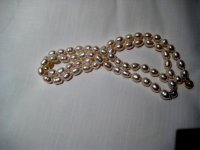J
jerin
Guest
Jerin, I am trying to detect orient - I always think I know it when I see it, but defining it is a whole different ball game! Do you mean the pearl in the middle of the top row of pearls in the multicoloured strand? And do you mean the pearl at the right close to the bottom of the picture in the white strand?
Thanks!
Nerida
Nerida, I am talking of #7, there it is the sixth pearl in the upper row that shows very fine orient and then I was talking about the big baroque strand that Olga has, there it was a pearl on the extreme right side that very clearly shows the orient, in her strand there are several with orient but not so clear as the one on the right side, though.
Your strand of the dark fireballs is amazing. Very lovely to look at and unusual.
I think one way to see a difference whether it is orient or dye may be the "oily" look, that is not orient. Orient is much more fleeting, rather weak colours compared to the oily ones.

